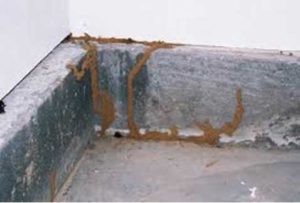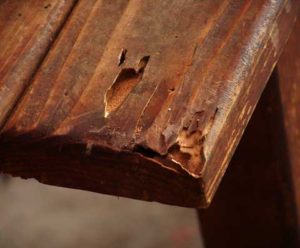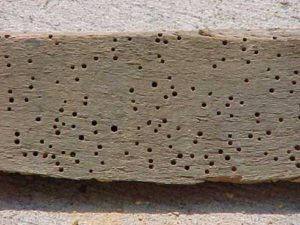What does termite damage look like?
Whilst in your home you may walk past some funny looking stuff on the floor boards. It’s kind of dark and in a line, but disappears after a few centimetres. Probably just a stain or something, right?
Well it might be, but when it comes to termite damage a homeowner should always have a decent understanding of the appearance of wood pest damage just in case the mark on the skirting board isn’t “just nothing”.
Something you might see quite commonly around a termite infested house are mud tunnels. These are like little subways termites use to stay out of the direct light. They create these because they have a very thin exoskeleton, which means they get dehydrated very easily when in the sunlight and can die. Termites thrive in moist conditions, and they need to obtain a certain level of hydration to stay alive. This is why termites are always found in dark places beneath the subfloor or in the ceiling and in mulched areas.
Mud tunnels are constructed out of, that’s right, mud! Termites gather dirt and use moisture to develop a tunnel to travel through safely during the day. In most cases they will do this when searching for more food, so it is common to see these over hard materials that they cannot consume, like brick walls or cement floors.
 Mud tunnels along concrete leading into cracks in the wall and floor
Mud tunnels along concrete leading into cracks in the wall and floor
If you spot some of these around the home, try breaking one open and see if there is any activity. You should see worker termites, which are small and slightly translucent. If there is no activity they may have abandoned that tunnel and moved on to another area of the house.
A different kind of activity you may notice is damage to wood itself. Remember, wood houses are not necessarily the only kinds of structures that are in danger of termite infestation. Termites can travel through other materials like plaster, and can even travel over dense materials like steel. They are also able to gain access to homes through the smallest of cracks, so any house could be in danger of attack. Termites will also attack furniture if given the opportunity. Hungry termites will construct a colony within cabinets or bookshelves, and chew away at the veneer until cracking begins to appear on the surface. Cracking will become visible often when it is already too late and it will crack with the grain and be easy to break apart with your hands. You may also notice dust residue in or around furniture, which is equally likely to be termite excrement as just plain wood particles.
Some say termites go for antique furniture because they particularly like the aged wood. Like a good vintage wine, you might say.
 “1968 Birch Maple eh? very good year”, thinks the termite before taking the first devastating bite.
“1968 Birch Maple eh? very good year”, thinks the termite before taking the first devastating bite.
Then again, termites (like some of us) love fast food and will often just go for the closest meal.
You may see little holes in wood, sometimes lots of them! These are what are known as “Flight holes”. They are there to assist in the expansion of the colony. Once a colony has grown too big in one area, various other winged termites will travel through these flight holes from the central colony and migrate to another suitable area where they can begin another colony. This is bad news – if you see these somewhere around your house, it probably means you have one fully grown colony and another about to start up somewhere else around your home.
Sometimes you may see “flight holes” with mud covering some or all of it. This is preparation for the flight to come. If later you notice wings lying around in certain parts like near skirting boards, this will mean that the colony is beginning the next phase of establishment by evolving into a higher class of termite, like kings or queens.
Flight holes from a piece of timber
If you are unsure of particular signs or damage, getting a timber pest inspection done on your entire home will help determine whether there is a serious problem and what to do about it.






